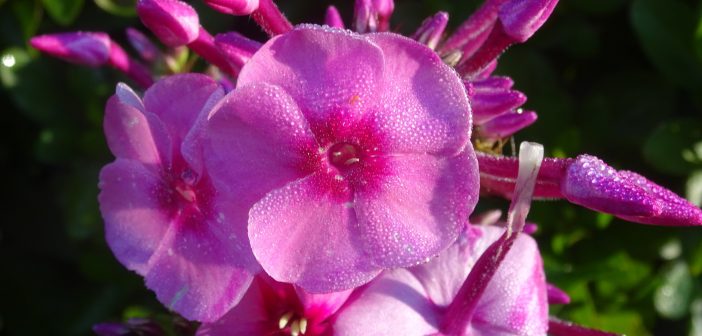Native plants contribute to a backyard wildlife habitat in the best possible ways: They evolved over hundreds of years in lockstep with other living things in a balanced native ecosystem, so they require less maintenance, less fertilizer, and less water. They present a naturalized look and feel to a backyard, and many have beautiful flowers. Most importantly, they provide exactly what urban wildlife clamors for—nectar, berries, seeds, and cover.
If wildflowers are just a bit too wild-looking for your taste, then mix them in groups among hybridized species or even plant them behind tamer-looking varieties. Above all, don’t leave them completely out, they’re important sources of nectar and pollen for butterflies, bees, and other insects; nectar and seeds for birds; and fruits and seeds for other animals.
Wildflower plants and seeds are available through many sources: Garden centers carry them (although choices are often limited). Local farmers’ markets often have sellers of homegrown plants and seeds. The internet has many listings for wildflower nurseries. Local native plant clubs exchange seeds and plants. If you’d like to take seeds from the wild, be sure to collect them responsibly.
The following list is far from complete—there are many more native species that do well in a backyard environment. Check with your County Extension Service or garden center for a list of the best native plants for your location. Also, there’s tons of information here: USDA Plant Database.
*Wildlife value: F= fruit; S = seeds; N= nectar; H= host plant for butterfly larvae
| Perennials (unless otherwise noted) | Some suggested species | Latin name | Wildlife Value* |
| Aster | New York, Smooth, Aromatic | Aster spp. | S, N, H |
| Beebalm (aka Bergamot) | Scarlet Beebalm, Eastern Beebalm, Wild Bergamot, Purple Bergamot | Monarda spp. | S, H |
| Blazing Star (aka Gayfeather) | Tall, Rough, Dwarf, Summer, Dense | Liatris spp. | S, N |
| Butterfly Weed | Asclepias tuberosa | N, H | |
| Cardinal Flower | Lobelia cardinalis | N, H | |
| Columbine | Eastern Red, Golden, Colorado Blue | Aquilegia spp. | S, H, N |
| Honeysuckle (vine) | Coral Honeysuckle | Lonicera sempervirens | N, H |
| Coreopsis (aka Tickseed) | Threadleaf Coreopsis, Lance-leaf Coreopsis, Common Tickseed | Coreopsis spp. | S, N |
| Coneflower | Purple, Yellow, Topeka, Smooth | Echinacea spp. | S, N |
| Desert Marigold (biennial) | Balleya multiradiata | S | |
Dutchman’s Pipevine (vine) | Aristochia macrophylla | N | |
Gayfeather (aka Blazing Star) | Narrow-leaf, Spiked, Sharp | Liatris spp. | S, N |
| Goldenrod | Canada, Drummond’s, Ohio, Giant, Nuttall’s | Solidago spp. | S, N |
| Indian Pink | Spigelia marylandica | N, H |
| Ironweed | Veronica noveboracensis | N | |
| Milkweed | Common, Swamp, White, Sullivant’s | Asclepias spp. | N, H |
| Monkeyflower | Mimulus ringens | N, H | |
| Passionflower (vine) | Passiflora incarnata | F, N, H | |
| Penstemon (aka Beardtongue) | Smooth, Foxglove, Scarlet Bugler | Penstemon spp. | N, H |
| Phlox | Blue, Prairie, Summer, Carolina | Phlox spp. | N |
| Rose Mallow | Hibiscus moscheutos | N, H | |
| Salvia (annuals, perennials) | Scarlet Sage, Purple Sage, Blue Sage, Mountain Sage, Hummingbird Sage | Salvia spp. | N, H |
| Scarlet Globemallow | Sphaeralcea coccinea | F, N | |
| Spotted Jewelweed | Impatiens capensis | N |
| Summer Grape (vine) | Vitis aestivalis | F | |
| Sunflower | Helianthus spp. | S, N, H | |
| Trumpet Vine (vine) | Campsis radicans | H | |
| Verbena | Verbena canadensis | N | |
| Virginia Creeper (vine) | Parthenocissus quinquefolia | F, N | |
| White False Indigo | Baptisia leucantha | N, H | |
| Wild Bergamot (aka Beebalm) | Monarda fistulosa | N, H | |
| White False Indigo | Baptisia leucantha | N, H | |
| Wild Geranium | Geranium maculatum | S, N | |
| Wild Strawberry | Fragaria virginiana | H | |
| Wood Vetch | Vicia caroliniana | S, H |
America’s favorite butterflies
All about the Virginia Opossum
Native annuals for butterflies
Earthworm questions you didn’t know you had
Mammals in your yard






